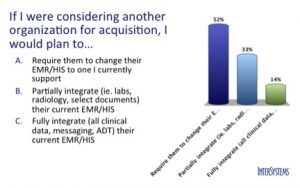There’s no question that we’re in the midst of a strong wave of healthcare mergers and acquisitions, with no end in sight. There were over 500 hospital consolidations from 2008-2012. As a practicing physician and “reformed” CMIO, I’ve experienced both sides of the equation – having worked with those that acquire and those that are acquired. I can personally attest to the fact that neither is very much fun.
My colleague Kathleen Aller wrote an earlier blog on consolidation, "Always One Acquisition Away." Some of the key messages from that piece – application diversity is the norm, you’re always “one acquisition away” from a hybrid system – really resonated with the themes I’ve been hearing in my own travels about the country. In the face of this growing trend, it’s also clear that for most folks out there, interoperability isn’t where we’d like it to be.
Recently I led a workshop at the Healthcare IT Summit addressing the importance of interoperability in the context of healthcare industry consolidation. I want to share with you two questions that I asked the crowd that day. The answers were a little disappointing if not entirely surprising.

Here we see that roughly a third of those polled (high-level healthcare IT types) think their interoperability capabilities are good enough to be counted as a net positive when it comes to acquiring another organization. This is great!
What’s less great, though, is that just as many people think their interoperability solution holds them back.

This one is a bit sobering. The larger an organization gets, the harder and harder it is to keep that uniform IT environment. Yet still in this day and age, over half of us are electing to do what I call “interoperability the hard way” – restricting IT solutions to a single walled garden of vendor offerings.
Don’t get me wrong; I’m a big fan of walled gardens (hello, Apple), but that only works if all of what you need exists within that garden. And with healthcare continuing to specialize and subspecialize, that’s going to be less and less the case.
One might argue that strong interoperability capabilities cost good money. Nobody would contest that. But one also has to look at the costs, both financial and strategic, of being short on interoperability strength and having to rip and replace, retrain, increase time to readiness, limit strategic choices due to IT capabilities, or become increasingly reliant upon a single vendor (while those vendor choices seem to dwindle continuously).
Where do your own capabilities lie, and where would you like them to be?




































